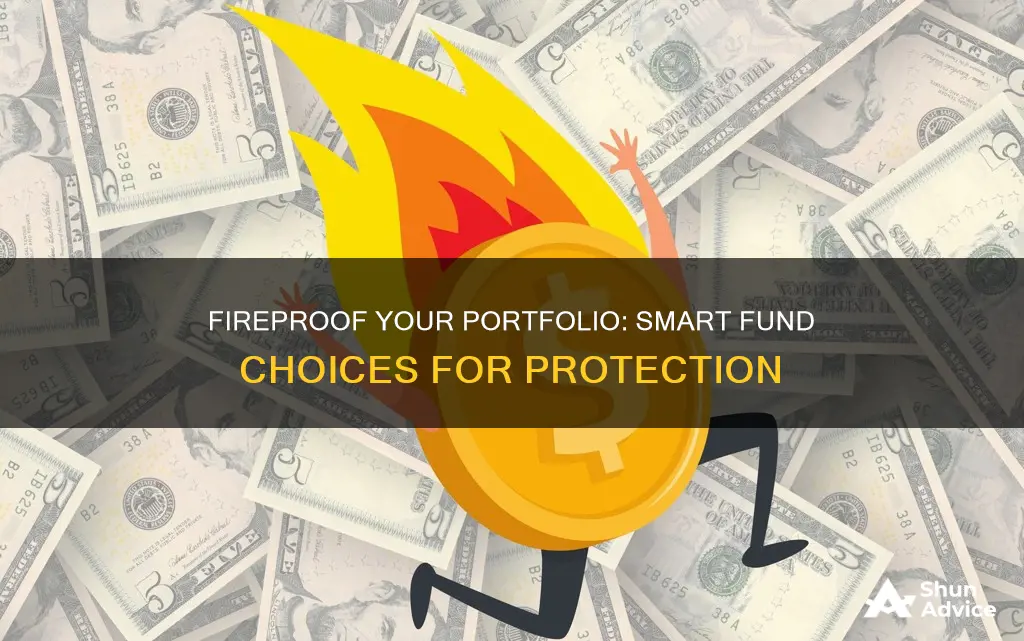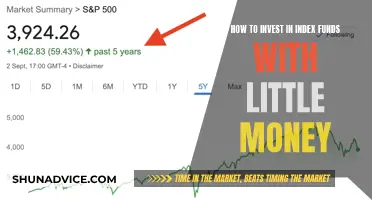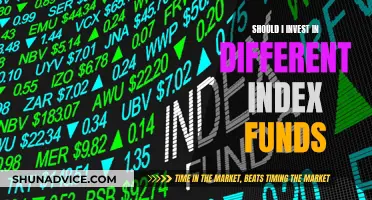
Investing is a key pillar of FIRE (Financial Independence, Retire Early). There are many different types of investments to consider, including stocks, bonds, mutual funds, index funds, and exchange-traded funds (ETFs).
Index funds are a popular choice for FIRE adherents, as they are relatively safe, low-cost, and provide good returns with minimal risk. Index funds are passively managed, meaning they don't have to pay fund managers, which results in lower fees for investors.
ETFs are similar to mutual funds but are bought and sold on stock market exchanges like stocks. They are also popular among FIRE investors as they are affordable, highly liquid, and can be bought with a small amount of money.
Other investment options include stocks, which are riskier but offer the potential for higher returns, and cryptocurrencies, which are very risky but can provide faster returns.
Ultimately, the best investment strategy depends on an individual's risk tolerance, financial goals, and time horizon. It is important to do your own research and consult with a financial advisor before making any investment decisions.
| Characteristics | Values |
|---|---|
| Investment Options | Stocks, Mutual funds, Index funds, Exchange-traded funds (ETFs), Cryptocurrency |
| Advantages of Stocks | Liquid investment, Advanced trading options, Low-cost investment, Tax-efficient investing vehicle |
| Disadvantages of Stocks | Riskiest option, Lack of diversification |
| Advantages of Mutual Funds | Diversification, Professional oversight, Dollar-cost averaging |
| Disadvantages of Mutual Funds | High cost, Lack of liquidity, High investment minimums |
| Index Funds | A type of mutual fund that attempts to replicate an index as closely as possible |
| Advantages of Index Funds | Cost-effective, Passive investing, Better returns than actively managed mutual funds |
| Exchange-traded funds (ETFs) | Bought and sold on stock market exchanges just like stocks, No investment minimums |
| Disadvantages of ETFs | Some brokers charge commissions on ETF trades, Investors cannot buy fractional shares of ETFs |
| FIRE Retirement and the 4% Rule | The 4% Rule calculates how much a retiree can spend each year during retirement without running out of money |
| FIRE Investment Strategy | Low-cost investing strategy based on index funds, Portfolios are heavily weighted toward equities, Self-managed |
| Recommended Funds | Vanguard Total Stock Market (ETF) - VTI, Vanguard Total Bond Market Index (ETF) - BND, Vanguard Total International Stock Index Fund - VXUS, Vanguard Small-Cap Index ETF - VB, Vanguard REIT Index Fund - VNQ, Vanguard Social Index Fund Admiral Shares - VFTAX, Vanguard Target Retirement 2050 Fund Investor Shares - VFIFX, Vanguard Growth Index Fund Admiral Shares - VIGAX, Vanguard 500 Index Fund Admiral Shares -VFIAX |
What You'll Learn

Stock vs Bond
When it comes to investing, stocks and bonds are two of the most traded types of assets. However, they come with different risks and rewards, and it's important to understand the differences before deciding where to put your money.
Stocks
Stocks, also known as corporate stock, common stock, corporate shares, equity shares or equity securities, represent partial ownership or equity in a company. When you buy stock, you purchase one or more shares, and the more shares you buy, the more of the company you own. The value of your investment grows as the company performs well and the price of its shares increases. Stocks are traded on stock exchanges, such as Nasdaq and the New York Stock Exchange (NYSE) in the United States.
One of the biggest advantages of stocks is that they are liquid investments, meaning they can be bought or sold at any time during open market hours or after-market hours. They also come with advanced trading options, like the ability to make stop-loss and trailing-loss orders, which can help limit your risk. Additionally, stocks can be low-cost investments since you're not paying fund managers, and there are generally no annual expenses or sales loads.
However, stocks are considered riskier than bonds because their performance depends on the success of a single company. If the company performs poorly, the value of your shares can decrease, resulting in a loss if you sell. Stocks are also subject to various risks, such as country or geopolitical risk, currency risk, liquidity risk, and interest rate risks.
Bonds
Bonds, on the other hand, are loans made to a company, government, or municipality. When you buy a bond, you are lending money for a set period and receiving interest payments over time. Bonds typically have fixed interest rates, so you are assured a specific yield on your investment, although it may be lower than what you might get from stocks. Bonds are traded on the bond market, also known as the debt or credit market, and they are usually sold over the counter rather than in a centralized location.
Bonds are generally considered more conservative and safer investments than stocks. They provide investors with a steady, regular income and are often used to save for retirement or other long-term goals. However, bonds are not entirely risk-free. They are susceptible to risks such as inflation and interest rates, and if the issuing company goes bankrupt, you may stop receiving interest payments and lose your principal investment.
Stocks vs Bonds
Both stocks and bonds aim to grow your money, but they do it in different ways and with varying returns. Stocks offer the potential for higher returns but come with greater risk, while bonds provide more predictable fixed income with lower risk. Stocks are ideal for those seeking higher returns and are willing to take on more risk, whereas bonds are better suited for those seeking a more conservative, stable investment.
Additionally, stocks and bonds react differently to adverse events, so diversifying your portfolio by including both can add stability and potentially reduce overall investment risk. The ideal mix of stocks and bonds depends on your investment goals, risk tolerance, and time horizon. Younger investors with a longer time horizon may opt for a more aggressive portfolio with a higher proportion of stocks, while older investors nearing retirement may prefer a more conservative portfolio with a larger allocation of bonds.
In summary, stocks and bonds each have their own advantages and disadvantages, and neither is inherently better than the other. The best choice for you depends on your financial goals, risk tolerance, and investment timeline.
Investing Now: Choosing the Right Funds for Your Portfolio
You may want to see also

Roth vs Traditional IRA
When it comes to investing for FIRE, one of the key decisions you'll need to make is whether to use a Roth IRA or a traditional IRA. Both types of accounts offer tax advantages, but they differ in several ways, including eligibility requirements, contribution limits, tax treatment, and distribution rules. Here's a detailed comparison to help you understand the differences between Roth and Traditional IRAs:
Eligibility:
The eligibility requirements for Roth and Traditional IRAs differ primarily based on income levels and tax filing status. Anyone with earned income can generally contribute to a Traditional IRA, but tax deductibility may be reduced or eliminated at higher income levels, especially if you or your spouse has access to a workplace retirement plan. In contrast, Roth IRAs have income caps beyond which individuals cannot contribute at all. For 2024, the income limits for contributing to a Roth IRA are less than $146,000 for single filers and less than $230,000 for married couples filing jointly. It's important to determine your eligibility before choosing which type of IRA to open, as it will impact your tax advantages and overall financial strategy.
Contributions:
Both Roth and Traditional IRAs have contribution limits set by the IRS. For the 2024 tax year, if you're under age 50, you can contribute up to $7,000, and if you're age 50 or older, the limit is $8,000. These limits may be lower based on your income. Additionally, Roth IRA contributions cannot exceed the amount of income you earned that year, while Traditional IRAs only require that contributions don't exceed the IRS-imposed limits, regardless of your income.
Tax Treatment:
The main difference between Roth and Traditional IRAs lies in their tax treatment. Roth IRAs offer tax-free growth and withdrawals, meaning you contribute money that has already been taxed, and any earnings in the account grow tax-free. Withdrawals of contributions and earnings are generally tax-free as long as you meet certain requirements, such as reaching age 59½ and satisfying a 5-year holding period. On the other hand, Traditional IRAs provide tax-deferred growth, allowing you to make pre-tax contributions that reduce your taxable income for the current tax year. However, you will pay taxes on any earnings and contributions when you make withdrawals in retirement.
Distributions:
Roth IRAs offer more flexibility when it comes to distributions. There are no required minimum distributions (RMDs) during the account owner's lifetime, so you can leave your money in the account to continue growing tax-free. With Traditional IRAs, you are generally required to start taking RMDs at age 73 (as per the SECURE Act). Additionally, withdrawals from a Roth IRA are typically tax-free, while withdrawals from a Traditional IRA are subject to ordinary income tax. Early withdrawals from either type of account before age 59½ may incur a 10% early withdrawal penalty, although there are certain exceptions to this rule for both Roth and Traditional IRAs.
Choosing Between Roth and Traditional IRA:
The decision to choose between a Roth or Traditional IRA depends on several factors:
- Current and expected future income levels: If you anticipate being in a higher tax bracket in retirement, a Roth IRA may be more advantageous due to its tax-free withdrawals.
- Age and retirement timeline: Younger investors often prefer a Roth IRA to take advantage of tax-free growth over a longer period.
- Tax-filing status and income: These factors determine your eligibility for deductions (Traditional IRA) or contributions (Roth IRA).
- Retirement goals and financial needs: Consider when you plan to access the funds and whether you'll need the money before retirement.
Where Fund Managers Put Their Own Money
You may want to see also

Mutual Funds
There are several pros to investing in mutual funds. Firstly, they offer automatic diversification. Secondly, you can match them to your specific risk profile. The five most common types of mutual fund categories are:
- Growth – consists of stocks that are poised to have above-average growth
- Growth and Income – consists of both growth stocks and stocks that pay dividends
- Value – consists of stocks that are believed to be underpriced
- Balanced Funds – consists of both stocks and bonds
- Target-Date Funds – the portfolio of this type of fund changes to become more conservative over time
Another advantage of mutual funds is that they often come with professional fund managers, which can add a layer of comfort and security for new investors, although this does add fees. Most mutual funds also allow investors to buy fractional shares, making it easier to invest specific dollar amounts on a consistent basis.
However, mutual funds also have some cons. They can be costly, with expense ratios ranging from 0.50% to 1.5%. Many mutual funds also come with upfront sales loads, which can be up to 8.5% of the amount invested. Mutual funds are also not as liquid as stocks and can only be traded once a day after the market closes. Finally, mutual funds often come with investment minimums of $1,000 or more.
Selling Investment Funds: Knowing When to Let Go
You may want to see also

Index Funds
- Fidelity ZERO Large-Cap Index Fund (FNILX): This fund is essentially an S&P 500 index fund but without the licensing costs, so it can be offered with absolutely no investment fees, making it appealing to thrifty FIRE enthusiasts. It has no minimum investment.
- Invesco QQQ Trust (QQQ): This exchange-traded fund (ETF) invests in the 100 largest non-financial stocks in the tech-heavy NASDAQ Composite index. It has a relatively low expense ratio of 0.2%. While it's not a great option for investors seeking diversification, it's safer than putting a significant chunk of your nest egg in a few individual stocks.
- Vanguard High Dividend Yield ETF (VYM): This fund seeks to replicate the performance of the FTSE High Dividend Yield Index and has a yield of 3.65% and an expense ratio of 0.06%. Its holdings consist of 414 stocks that are projected to produce above-average yields, primarily older companies with solid track records of profitability.
Fidelity Investments: Trade Free Funds and Their Benefits
You may want to see also

Exchange-Traded Funds (ETFs)
ETFs are a basket of securities that can be bought or sold through a brokerage firm on a stock exchange. They are offered on various asset classes, from traditional investments to alternative assets like commodities or currencies. Innovative ETF structures allow investors to short markets, gain leverage, and avoid short-term capital gains taxes.
ETFs can be categorised into the following:
- Index ETFs: Designed to track a particular index like the S&P 500 or NASDAQ.
- Fixed Income ETFs: Designed to provide exposure to different types of bonds, including US Treasury, corporate, municipal, international, and high-yield bonds.
- Sector and Industry ETFs: Designed to provide exposure to a particular industry, such as oil, pharmaceuticals, or high technology.
- Commodity ETFs: Designed to track the price of a commodity, such as gold, oil, or corn.
- Style ETFs: Designed to track an investment style or market capitalization focus, such as large-cap value or small-cap growth.
- Foreign Market ETFs: Designed to track non-US markets, such as Japan's Nikkei Index or Hong Kong's Hang Seng Index.
- Inverse ETFs: Designed to profit from a decline in the underlying market or index.
- Leveraged ETFs: Designed to use leverage to amplify returns.
- Actively Managed ETFs: Designed to outperform an index, unlike most ETFs, which are designed to track an index.
- Exchange-Traded Notes (ETNs): Debt securities backed by the creditworthiness of the issuing bank, providing access to illiquid markets and generating minimal short-term capital gains taxes.
- Alternative Investment ETFs: Innovative structures that allow investors to trade volatility or gain exposure to a particular investment strategy, such as currency carry or covered call writing.
ETFs are an excellent vehicle for achieving an investor's goals, offering benefits such as easy trading, transparency, and tax efficiency. However, they also have some drawbacks, including trading costs, illiquidity, and tracking errors.
Nas' Venture Capital: Where Does He Invest?
You may want to see also
Frequently asked questions
FIRE stands for Financial Independence, Retire Early. The FIRE movement focuses on expenses, not income. The FIRE movement believes that Financial Independence requires saving 25 times your annual expenses. This is derived from the 4% rule, which calculates how much a retiree can spend each year during retirement without running out of money.
The 4% rule states that in the first year of retirement, a retiree can spend 4% of their portfolio. Beginning in the second year, the retiree adjusts the prior year’s spending by the rate of inflation. Following this simple spending rule, retirement portfolios should last at least 30 years, even during bad markets and high inflation.
Most FIRE adherents follow a low-cost investing strategy based on index funds. Portfolios are heavily weighted toward equities and are self-managed.
Index funds are a type of mutual fund with a portfolio constructed to match or track the components of a market index, such as the Standard & Poor’s 500 Index (S&P 500). An index fund is a type of mutual fund that attempts to replicate an index as closely as possible.
Some good index funds to invest in are:
- Vanguard Total Stock Market (ETF) - VTI
- Vanguard Total Bond Market Index (ETF) - BND
- Vanguard Total International Stock Index Fund - VXUS
- Vanguard Small-Cap Index ETF - VB
- Vanguard REIT Index Fund - VNQ
- Vanguard Social Index Fund Admiral Shares - VFTAX
- Vanguard Target Retirement 2050 Fund Investor Shares - VFIFX
- Vanguard Growth Index Fund Admiral Shares - VIGAX
- Vanguard 500 Index Fund Admiral Shares - VFIAX







